Leadership, Management and Operations Report - Analysis of Tasks
VerifiedAdded on 2022/12/28
|18
|4193
|446
Report
AI Summary
This report provides a comprehensive analysis of leadership and management principles, focusing on their application within an organizational context. The report begins by differentiating between the roles of leaders and managers, highlighting their respective responsibilities and characteristics. It then explores the situational context of leadership, using Marks & Spencer as a case study to illustrate how leadership adapts to changing environments, such as the rise of digital marketing and the challenges posed by the COVID-19 pandemic. Furthermore, the report delves into various leadership theories, including situational theory, systems approach theory, and contingency theory, providing examples and illustrations to clarify their practical application. The analysis extends to operations management, examining key strategies such as Lean Production, Business Process Re-Engineering (BPR), Six Sigma, and Just-in-Time (JIT) inventory management. The report also evaluates the strengths and weaknesses of these operational approaches. Overall, the report offers insights into effective leadership and operational strategies, providing a valuable resource for students studying management and leadership.
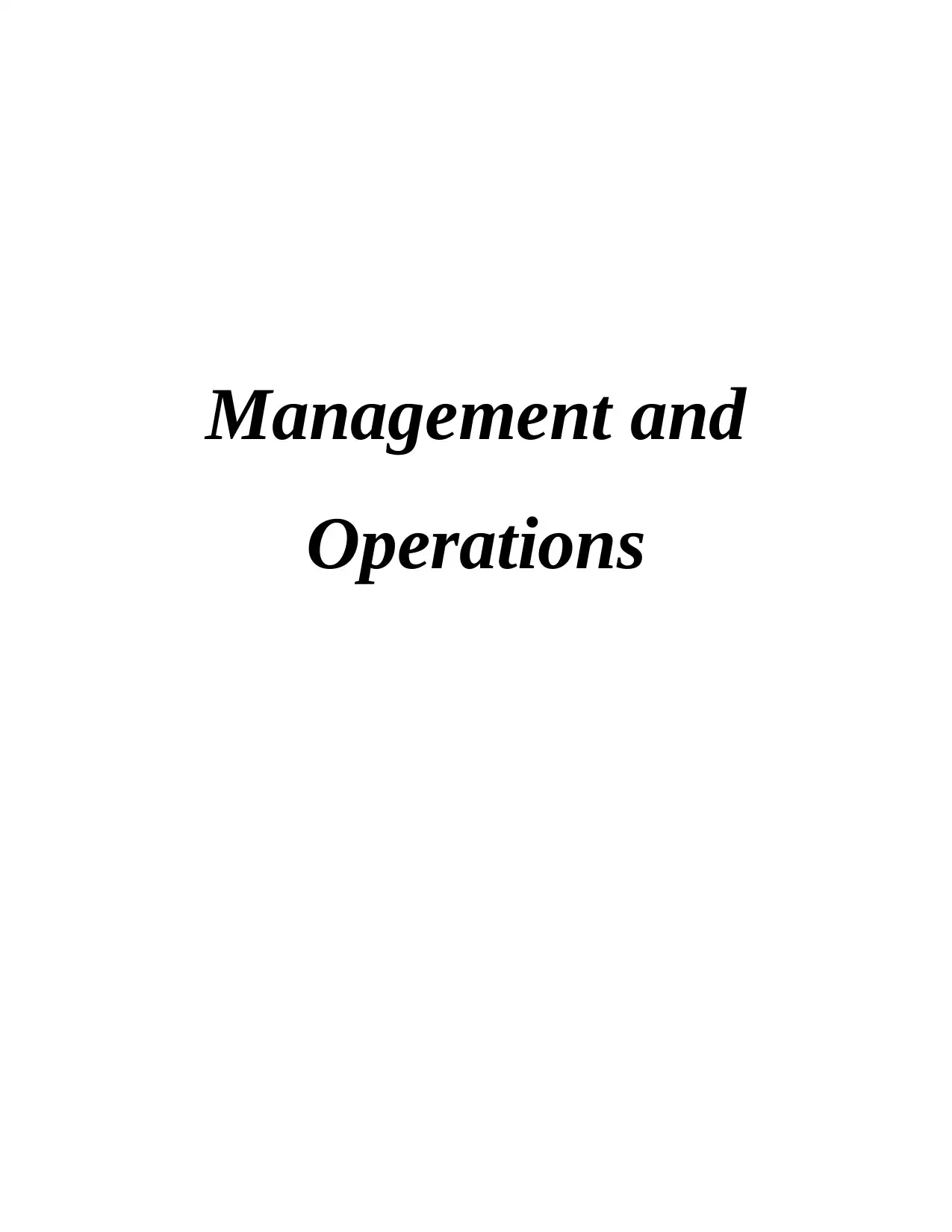
Management and
Operations
Operations
Paraphrase This Document
Need a fresh take? Get an instant paraphrase of this document with our AI Paraphraser
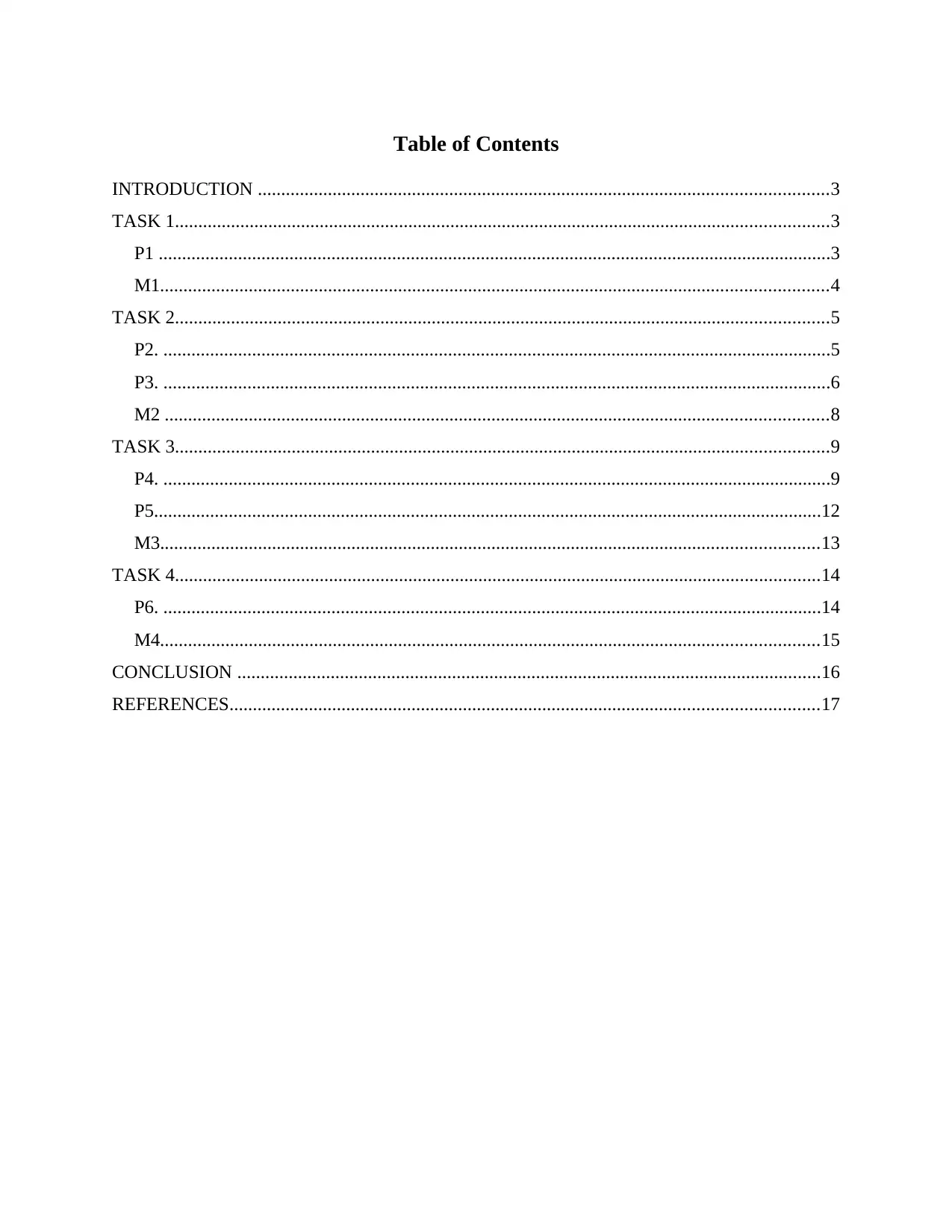
Table of Contents
INTRODUCTION ..........................................................................................................................3
TASK 1............................................................................................................................................3
P1 ................................................................................................................................................3
M1...............................................................................................................................................4
TASK 2............................................................................................................................................5
P2. ...............................................................................................................................................5
P3. ...............................................................................................................................................6
M2 ..............................................................................................................................................8
TASK 3............................................................................................................................................9
P4. ...............................................................................................................................................9
P5...............................................................................................................................................12
M3.............................................................................................................................................13
TASK 4..........................................................................................................................................14
P6. .............................................................................................................................................14
M4.............................................................................................................................................15
CONCLUSION .............................................................................................................................16
REFERENCES..............................................................................................................................17
INTRODUCTION ..........................................................................................................................3
TASK 1............................................................................................................................................3
P1 ................................................................................................................................................3
M1...............................................................................................................................................4
TASK 2............................................................................................................................................5
P2. ...............................................................................................................................................5
P3. ...............................................................................................................................................6
M2 ..............................................................................................................................................8
TASK 3............................................................................................................................................9
P4. ...............................................................................................................................................9
P5...............................................................................................................................................12
M3.............................................................................................................................................13
TASK 4..........................................................................................................................................14
P6. .............................................................................................................................................14
M4.............................................................................................................................................15
CONCLUSION .............................................................................................................................16
REFERENCES..............................................................................................................................17
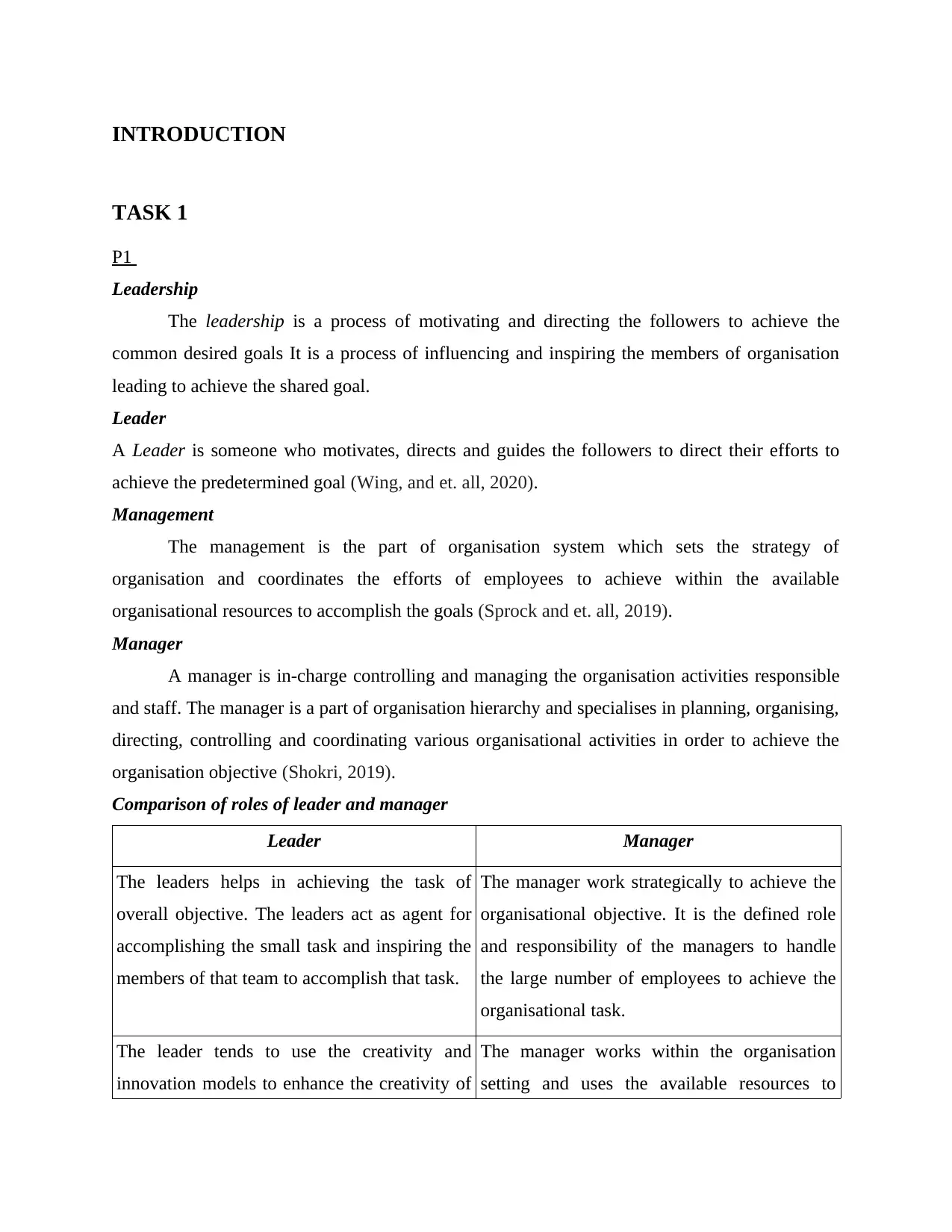
INTRODUCTION
TASK 1
P1
Leadership
The leadership is a process of motivating and directing the followers to achieve the
common desired goals It is a process of influencing and inspiring the members of organisation
leading to achieve the shared goal.
Leader
A Leader is someone who motivates, directs and guides the followers to direct their efforts to
achieve the predetermined goal (Wing, and et. all, 2020).
Management
The management is the part of organisation system which sets the strategy of
organisation and coordinates the efforts of employees to achieve within the available
organisational resources to accomplish the goals (Sprock and et. all, 2019).
Manager
A manager is in-charge controlling and managing the organisation activities responsible
and staff. The manager is a part of organisation hierarchy and specialises in planning, organising,
directing, controlling and coordinating various organisational activities in order to achieve the
organisation objective (Shokri, 2019).
Comparison of roles of leader and manager
Leader Manager
The leaders helps in achieving the task of
overall objective. The leaders act as agent for
accomplishing the small task and inspiring the
members of that team to accomplish that task.
The manager work strategically to achieve the
organisational objective. It is the defined role
and responsibility of the managers to handle
the large number of employees to achieve the
organisational task.
The leader tends to use the creativity and
innovation models to enhance the creativity of
The manager works within the organisation
setting and uses the available resources to
TASK 1
P1
Leadership
The leadership is a process of motivating and directing the followers to achieve the
common desired goals It is a process of influencing and inspiring the members of organisation
leading to achieve the shared goal.
Leader
A Leader is someone who motivates, directs and guides the followers to direct their efforts to
achieve the predetermined goal (Wing, and et. all, 2020).
Management
The management is the part of organisation system which sets the strategy of
organisation and coordinates the efforts of employees to achieve within the available
organisational resources to accomplish the goals (Sprock and et. all, 2019).
Manager
A manager is in-charge controlling and managing the organisation activities responsible
and staff. The manager is a part of organisation hierarchy and specialises in planning, organising,
directing, controlling and coordinating various organisational activities in order to achieve the
organisation objective (Shokri, 2019).
Comparison of roles of leader and manager
Leader Manager
The leaders helps in achieving the task of
overall objective. The leaders act as agent for
accomplishing the small task and inspiring the
members of that team to accomplish that task.
The manager work strategically to achieve the
organisational objective. It is the defined role
and responsibility of the managers to handle
the large number of employees to achieve the
organisational task.
The leader tends to use the creativity and
innovation models to enhance the creativity of
The manager works within the organisation
setting and uses the available resources to
⊘ This is a preview!⊘
Do you want full access?
Subscribe today to unlock all pages.

Trusted by 1+ million students worldwide
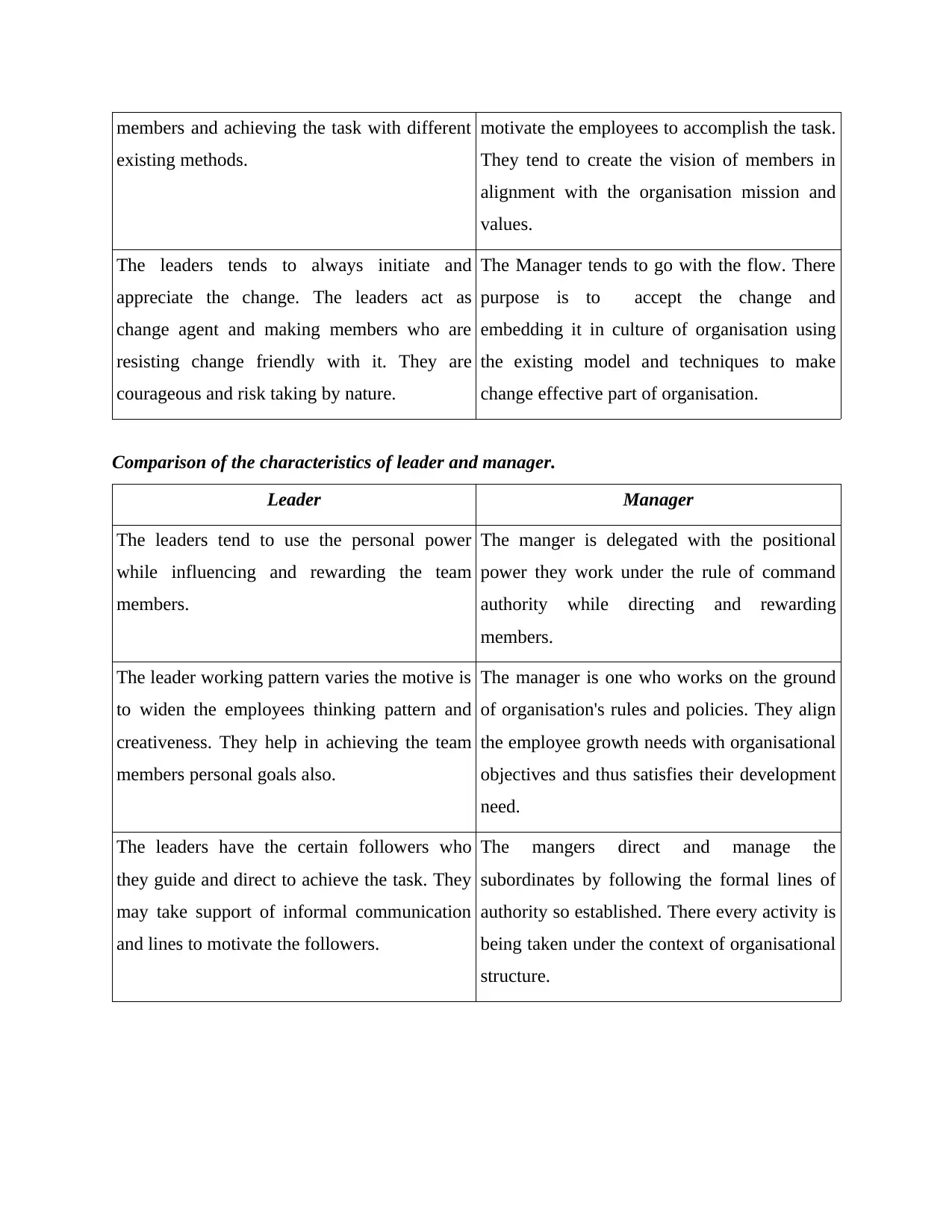
members and achieving the task with different
existing methods.
motivate the employees to accomplish the task.
They tend to create the vision of members in
alignment with the organisation mission and
values.
The leaders tends to always initiate and
appreciate the change. The leaders act as
change agent and making members who are
resisting change friendly with it. They are
courageous and risk taking by nature.
The Manager tends to go with the flow. There
purpose is to accept the change and
embedding it in culture of organisation using
the existing model and techniques to make
change effective part of organisation.
Comparison of the characteristics of leader and manager.
Leader Manager
The leaders tend to use the personal power
while influencing and rewarding the team
members.
The manger is delegated with the positional
power they work under the rule of command
authority while directing and rewarding
members.
The leader working pattern varies the motive is
to widen the employees thinking pattern and
creativeness. They help in achieving the team
members personal goals also.
The manager is one who works on the ground
of organisation's rules and policies. They align
the employee growth needs with organisational
objectives and thus satisfies their development
need.
The leaders have the certain followers who
they guide and direct to achieve the task. They
may take support of informal communication
and lines to motivate the followers.
The mangers direct and manage the
subordinates by following the formal lines of
authority so established. There every activity is
being taken under the context of organisational
structure.
existing methods.
motivate the employees to accomplish the task.
They tend to create the vision of members in
alignment with the organisation mission and
values.
The leaders tends to always initiate and
appreciate the change. The leaders act as
change agent and making members who are
resisting change friendly with it. They are
courageous and risk taking by nature.
The Manager tends to go with the flow. There
purpose is to accept the change and
embedding it in culture of organisation using
the existing model and techniques to make
change effective part of organisation.
Comparison of the characteristics of leader and manager.
Leader Manager
The leaders tend to use the personal power
while influencing and rewarding the team
members.
The manger is delegated with the positional
power they work under the rule of command
authority while directing and rewarding
members.
The leader working pattern varies the motive is
to widen the employees thinking pattern and
creativeness. They help in achieving the team
members personal goals also.
The manager is one who works on the ground
of organisation's rules and policies. They align
the employee growth needs with organisational
objectives and thus satisfies their development
need.
The leaders have the certain followers who
they guide and direct to achieve the task. They
may take support of informal communication
and lines to motivate the followers.
The mangers direct and manage the
subordinates by following the formal lines of
authority so established. There every activity is
being taken under the context of organisational
structure.
Paraphrase This Document
Need a fresh take? Get an instant paraphrase of this document with our AI Paraphraser
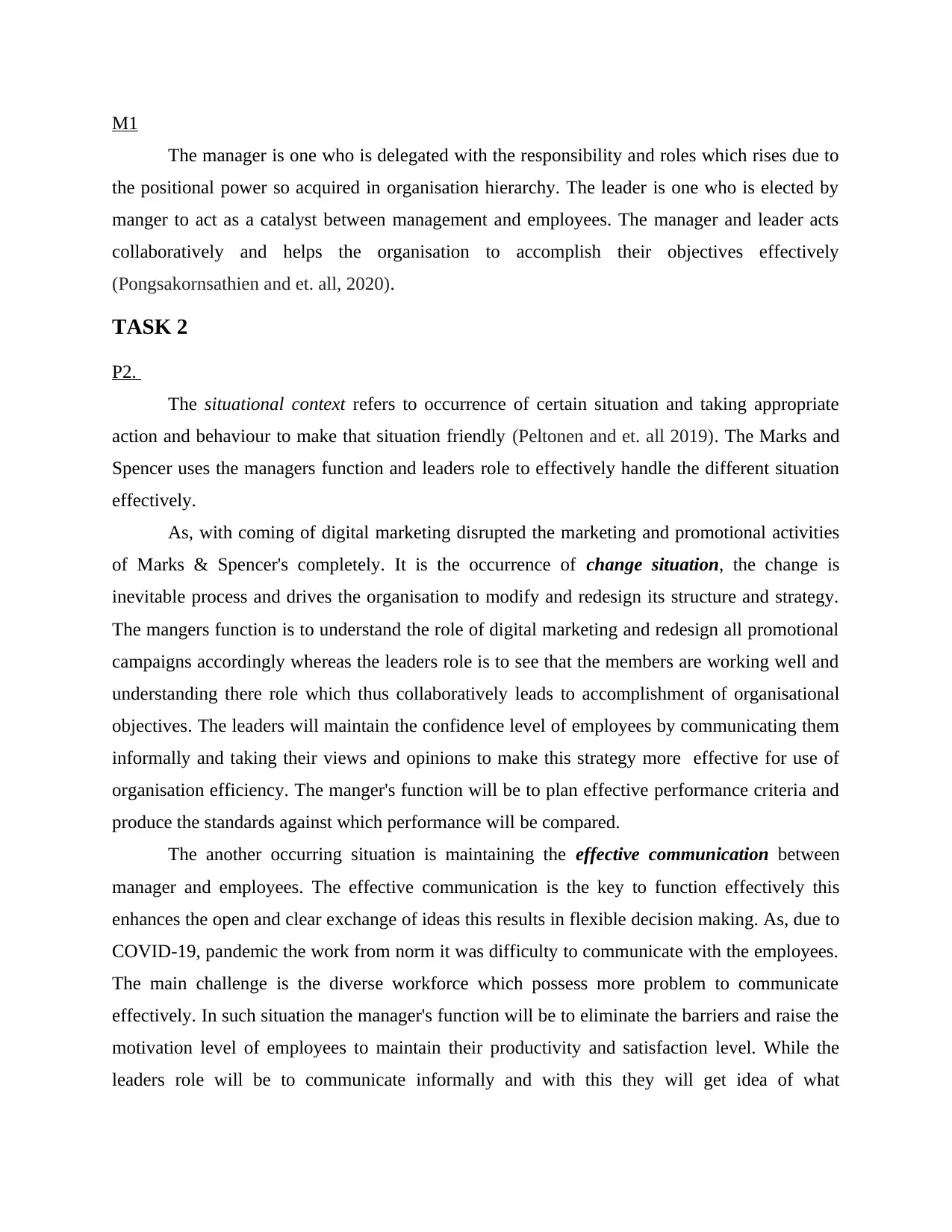
M1
The manager is one who is delegated with the responsibility and roles which rises due to
the positional power so acquired in organisation hierarchy. The leader is one who is elected by
manger to act as a catalyst between management and employees. The manager and leader acts
collaboratively and helps the organisation to accomplish their objectives effectively
(Pongsakornsathien and et. all, 2020).
TASK 2
P2.
The situational context refers to occurrence of certain situation and taking appropriate
action and behaviour to make that situation friendly (Peltonen and et. all 2019). The Marks and
Spencer uses the managers function and leaders role to effectively handle the different situation
effectively.
As, with coming of digital marketing disrupted the marketing and promotional activities
of Marks & Spencer's completely. It is the occurrence of change situation, the change is
inevitable process and drives the organisation to modify and redesign its structure and strategy.
The mangers function is to understand the role of digital marketing and redesign all promotional
campaigns accordingly whereas the leaders role is to see that the members are working well and
understanding there role which thus collaboratively leads to accomplishment of organisational
objectives. The leaders will maintain the confidence level of employees by communicating them
informally and taking their views and opinions to make this strategy more effective for use of
organisation efficiency. The manger's function will be to plan effective performance criteria and
produce the standards against which performance will be compared.
The another occurring situation is maintaining the effective communication between
manager and employees. The effective communication is the key to function effectively this
enhances the open and clear exchange of ideas this results in flexible decision making. As, due to
COVID-19, pandemic the work from norm it was difficulty to communicate with the employees.
The main challenge is the diverse workforce which possess more problem to communicate
effectively. In such situation the manager's function will be to eliminate the barriers and raise the
motivation level of employees to maintain their productivity and satisfaction level. While the
leaders role will be to communicate informally and with this they will get idea of what
The manager is one who is delegated with the responsibility and roles which rises due to
the positional power so acquired in organisation hierarchy. The leader is one who is elected by
manger to act as a catalyst between management and employees. The manager and leader acts
collaboratively and helps the organisation to accomplish their objectives effectively
(Pongsakornsathien and et. all, 2020).
TASK 2
P2.
The situational context refers to occurrence of certain situation and taking appropriate
action and behaviour to make that situation friendly (Peltonen and et. all 2019). The Marks and
Spencer uses the managers function and leaders role to effectively handle the different situation
effectively.
As, with coming of digital marketing disrupted the marketing and promotional activities
of Marks & Spencer's completely. It is the occurrence of change situation, the change is
inevitable process and drives the organisation to modify and redesign its structure and strategy.
The mangers function is to understand the role of digital marketing and redesign all promotional
campaigns accordingly whereas the leaders role is to see that the members are working well and
understanding there role which thus collaboratively leads to accomplishment of organisational
objectives. The leaders will maintain the confidence level of employees by communicating them
informally and taking their views and opinions to make this strategy more effective for use of
organisation efficiency. The manger's function will be to plan effective performance criteria and
produce the standards against which performance will be compared.
The another occurring situation is maintaining the effective communication between
manager and employees. The effective communication is the key to function effectively this
enhances the open and clear exchange of ideas this results in flexible decision making. As, due to
COVID-19, pandemic the work from norm it was difficulty to communicate with the employees.
The main challenge is the diverse workforce which possess more problem to communicate
effectively. In such situation the manager's function will be to eliminate the barriers and raise the
motivation level of employees to maintain their productivity and satisfaction level. While the
leaders role will be to communicate informally and with this they will get idea of what
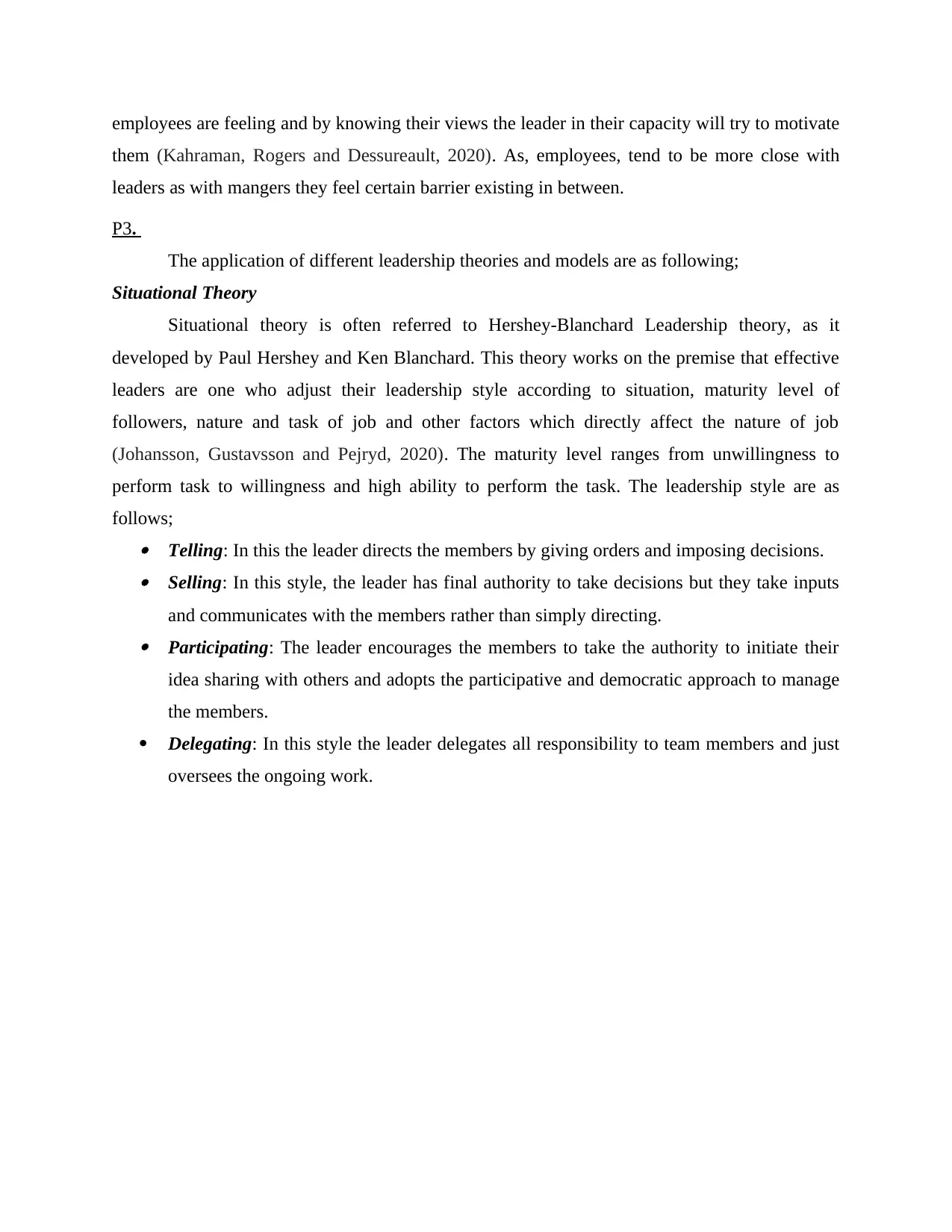
employees are feeling and by knowing their views the leader in their capacity will try to motivate
them (Kahraman, Rogers and Dessureault, 2020). As, employees, tend to be more close with
leaders as with mangers they feel certain barrier existing in between.
P3.
The application of different leadership theories and models are as following;
Situational Theory
Situational theory is often referred to Hershey-Blanchard Leadership theory, as it
developed by Paul Hershey and Ken Blanchard. This theory works on the premise that effective
leaders are one who adjust their leadership style according to situation, maturity level of
followers, nature and task of job and other factors which directly affect the nature of job
(Johansson, Gustavsson and Pejryd, 2020). The maturity level ranges from unwillingness to
perform task to willingness and high ability to perform the task. The leadership style are as
follows; Telling: In this the leader directs the members by giving orders and imposing decisions. Selling: In this style, the leader has final authority to take decisions but they take inputs
and communicates with the members rather than simply directing. Participating: The leader encourages the members to take the authority to initiate their
idea sharing with others and adopts the participative and democratic approach to manage
the members.
Delegating: In this style the leader delegates all responsibility to team members and just
oversees the ongoing work.
them (Kahraman, Rogers and Dessureault, 2020). As, employees, tend to be more close with
leaders as with mangers they feel certain barrier existing in between.
P3.
The application of different leadership theories and models are as following;
Situational Theory
Situational theory is often referred to Hershey-Blanchard Leadership theory, as it
developed by Paul Hershey and Ken Blanchard. This theory works on the premise that effective
leaders are one who adjust their leadership style according to situation, maturity level of
followers, nature and task of job and other factors which directly affect the nature of job
(Johansson, Gustavsson and Pejryd, 2020). The maturity level ranges from unwillingness to
perform task to willingness and high ability to perform the task. The leadership style are as
follows; Telling: In this the leader directs the members by giving orders and imposing decisions. Selling: In this style, the leader has final authority to take decisions but they take inputs
and communicates with the members rather than simply directing. Participating: The leader encourages the members to take the authority to initiate their
idea sharing with others and adopts the participative and democratic approach to manage
the members.
Delegating: In this style the leader delegates all responsibility to team members and just
oversees the ongoing work.
⊘ This is a preview!⊘
Do you want full access?
Subscribe today to unlock all pages.

Trusted by 1+ million students worldwide
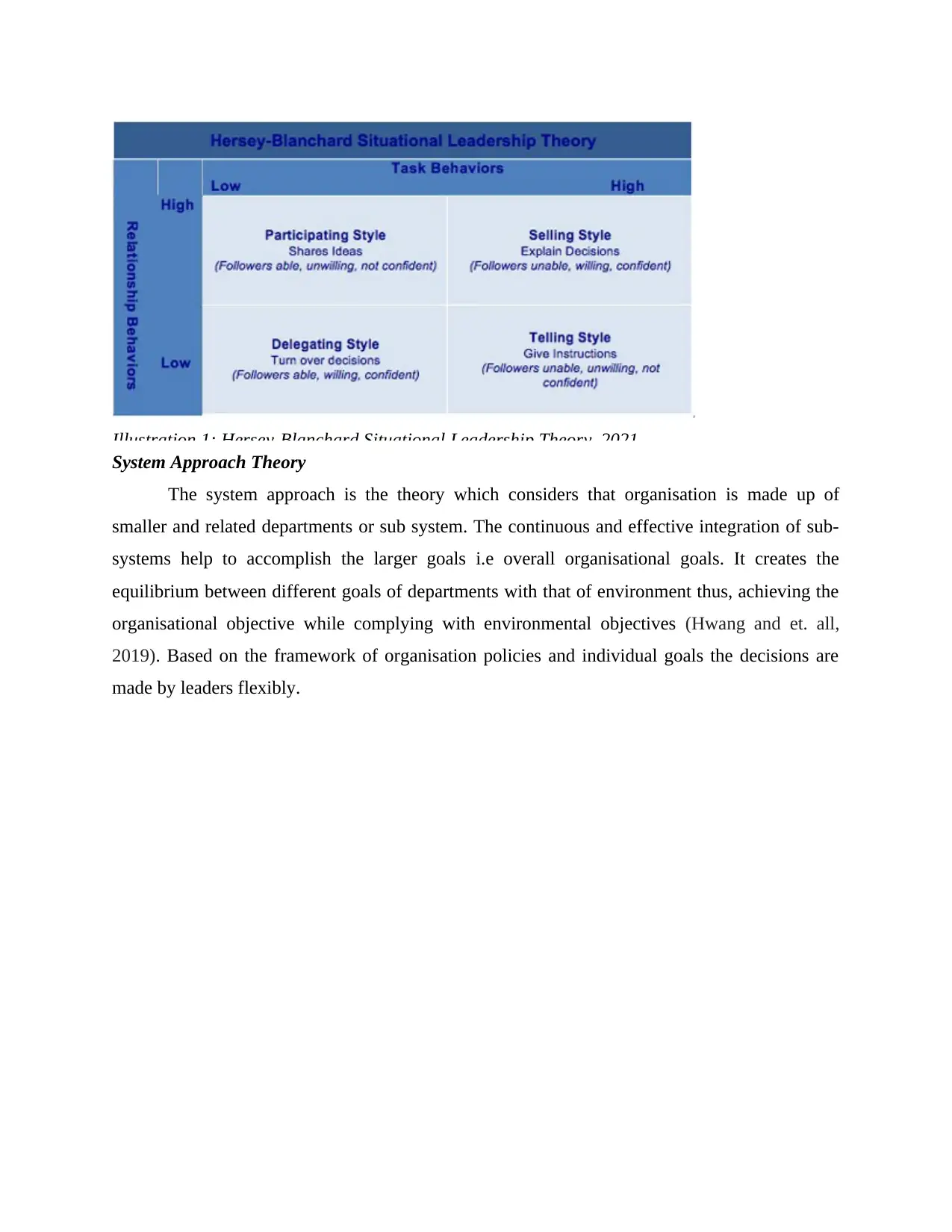
Illustration 1: Hersey-Blanchard Situational Leadership Theory, 2021
System Approach Theory
The system approach is the theory which considers that organisation is made up of
smaller and related departments or sub system. The continuous and effective integration of sub-
systems help to accomplish the larger goals i.e overall organisational goals. It creates the
equilibrium between different goals of departments with that of environment thus, achieving the
organisational objective while complying with environmental objectives (Hwang and et. all,
2019). Based on the framework of organisation policies and individual goals the decisions are
made by leaders flexibly.
System Approach Theory
The system approach is the theory which considers that organisation is made up of
smaller and related departments or sub system. The continuous and effective integration of sub-
systems help to accomplish the larger goals i.e overall organisational goals. It creates the
equilibrium between different goals of departments with that of environment thus, achieving the
organisational objective while complying with environmental objectives (Hwang and et. all,
2019). Based on the framework of organisation policies and individual goals the decisions are
made by leaders flexibly.
Paraphrase This Document
Need a fresh take? Get an instant paraphrase of this document with our AI Paraphraser
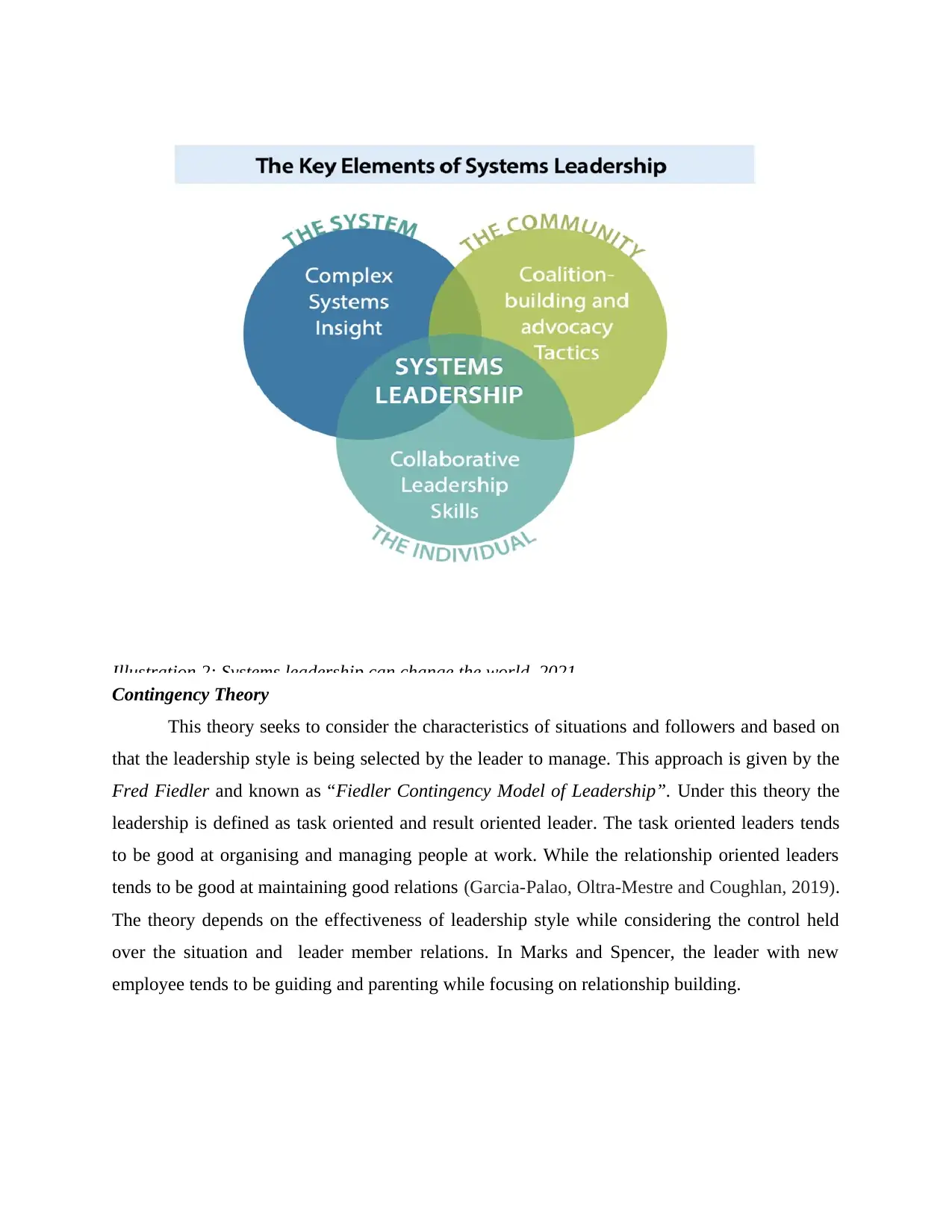
Illustration 2: Systems leadership can change the world, 2021
Contingency Theory
This theory seeks to consider the characteristics of situations and followers and based on
that the leadership style is being selected by the leader to manage. This approach is given by the
Fred Fiedler and known as “Fiedler Contingency Model of Leadership”. Under this theory the
leadership is defined as task oriented and result oriented leader. The task oriented leaders tends
to be good at organising and managing people at work. While the relationship oriented leaders
tends to be good at maintaining good relations (Garcia-Palao, Oltra-Mestre and Coughlan, 2019).
The theory depends on the effectiveness of leadership style while considering the control held
over the situation and leader member relations. In Marks and Spencer, the leader with new
employee tends to be guiding and parenting while focusing on relationship building.
Contingency Theory
This theory seeks to consider the characteristics of situations and followers and based on
that the leadership style is being selected by the leader to manage. This approach is given by the
Fred Fiedler and known as “Fiedler Contingency Model of Leadership”. Under this theory the
leadership is defined as task oriented and result oriented leader. The task oriented leaders tends
to be good at organising and managing people at work. While the relationship oriented leaders
tends to be good at maintaining good relations (Garcia-Palao, Oltra-Mestre and Coughlan, 2019).
The theory depends on the effectiveness of leadership style while considering the control held
over the situation and leader member relations. In Marks and Spencer, the leader with new
employee tends to be guiding and parenting while focusing on relationship building.
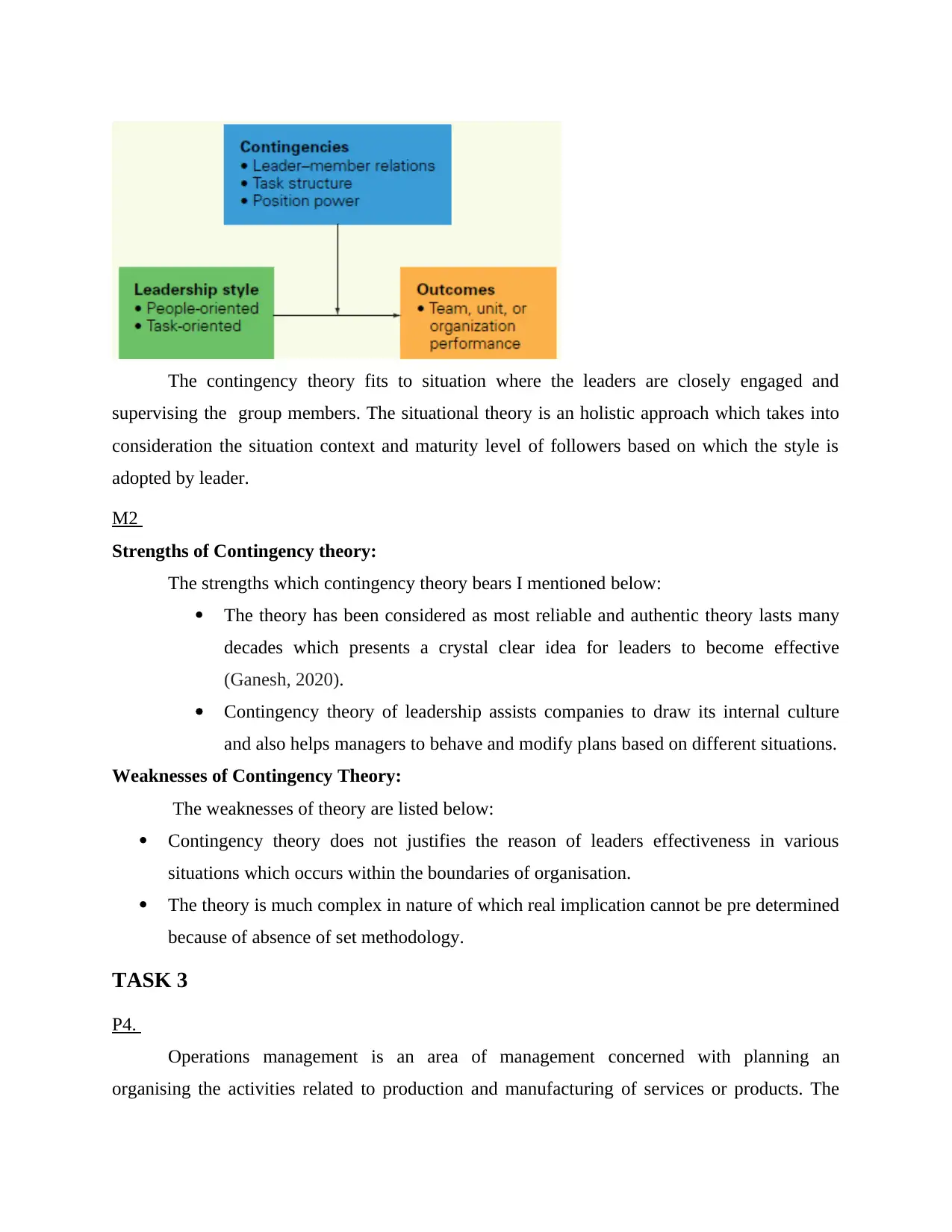
The contingency theory fits to situation where the leaders are closely engaged and
supervising the group members. The situational theory is an holistic approach which takes into
consideration the situation context and maturity level of followers based on which the style is
adopted by leader.
M2
Strengths of Contingency theory:
The strengths which contingency theory bears I mentioned below:
The theory has been considered as most reliable and authentic theory lasts many
decades which presents a crystal clear idea for leaders to become effective
(Ganesh, 2020).
Contingency theory of leadership assists companies to draw its internal culture
and also helps managers to behave and modify plans based on different situations.
Weaknesses of Contingency Theory:
The weaknesses of theory are listed below:
Contingency theory does not justifies the reason of leaders effectiveness in various
situations which occurs within the boundaries of organisation.
The theory is much complex in nature of which real implication cannot be pre determined
because of absence of set methodology.
TASK 3
P4.
Operations management is an area of management concerned with planning an
organising the activities related to production and manufacturing of services or products. The
supervising the group members. The situational theory is an holistic approach which takes into
consideration the situation context and maturity level of followers based on which the style is
adopted by leader.
M2
Strengths of Contingency theory:
The strengths which contingency theory bears I mentioned below:
The theory has been considered as most reliable and authentic theory lasts many
decades which presents a crystal clear idea for leaders to become effective
(Ganesh, 2020).
Contingency theory of leadership assists companies to draw its internal culture
and also helps managers to behave and modify plans based on different situations.
Weaknesses of Contingency Theory:
The weaknesses of theory are listed below:
Contingency theory does not justifies the reason of leaders effectiveness in various
situations which occurs within the boundaries of organisation.
The theory is much complex in nature of which real implication cannot be pre determined
because of absence of set methodology.
TASK 3
P4.
Operations management is an area of management concerned with planning an
organising the activities related to production and manufacturing of services or products. The
⊘ This is a preview!⊘
Do you want full access?
Subscribe today to unlock all pages.

Trusted by 1+ million students worldwide
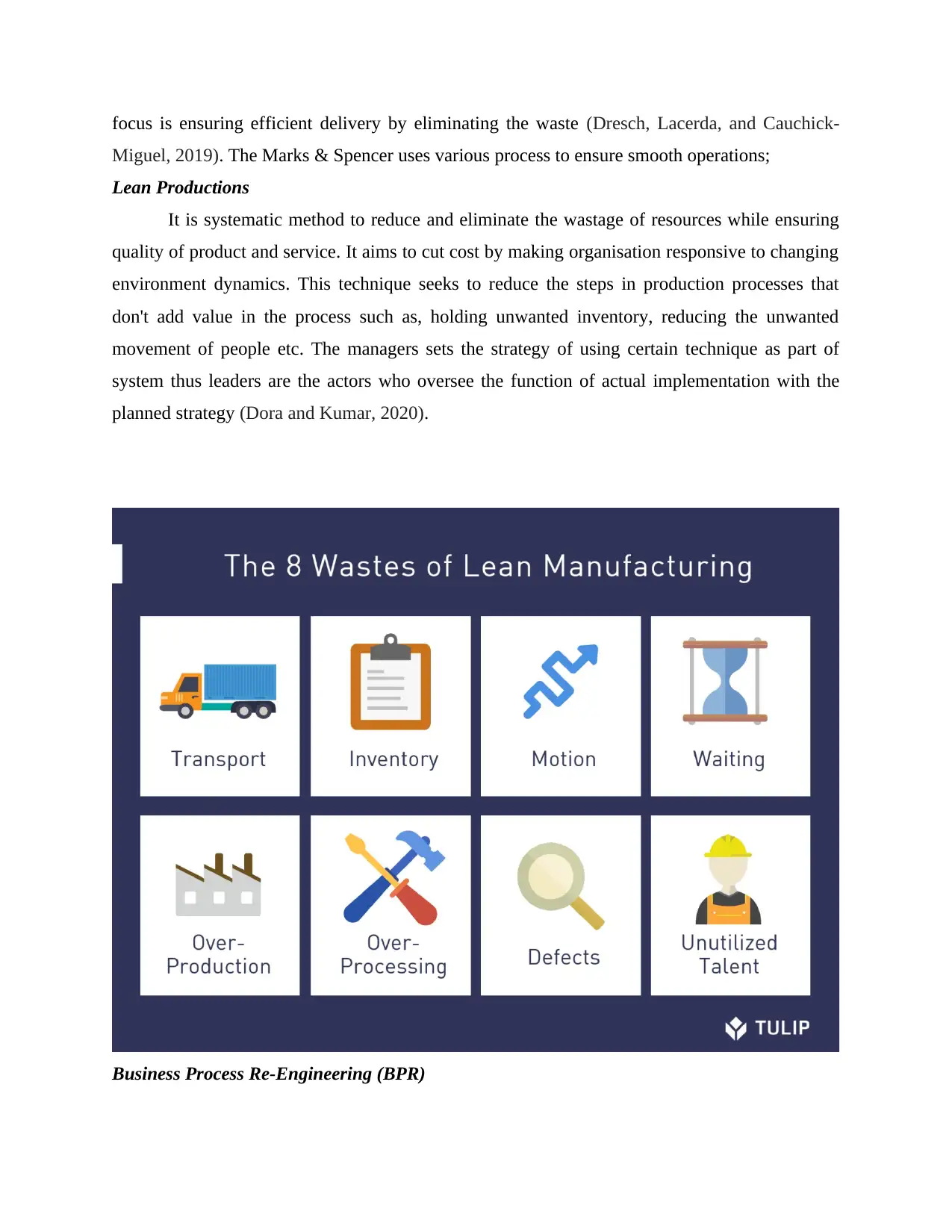
focus is ensuring efficient delivery by eliminating the waste (Dresch, Lacerda, and Cauchick-
Miguel, 2019). The Marks & Spencer uses various process to ensure smooth operations;
Lean Productions
It is systematic method to reduce and eliminate the wastage of resources while ensuring
quality of product and service. It aims to cut cost by making organisation responsive to changing
environment dynamics. This technique seeks to reduce the steps in production processes that
don't add value in the process such as, holding unwanted inventory, reducing the unwanted
movement of people etc. The managers sets the strategy of using certain technique as part of
system thus leaders are the actors who oversee the function of actual implementation with the
planned strategy (Dora and Kumar, 2020).
Business Process Re-Engineering (BPR)
Miguel, 2019). The Marks & Spencer uses various process to ensure smooth operations;
Lean Productions
It is systematic method to reduce and eliminate the wastage of resources while ensuring
quality of product and service. It aims to cut cost by making organisation responsive to changing
environment dynamics. This technique seeks to reduce the steps in production processes that
don't add value in the process such as, holding unwanted inventory, reducing the unwanted
movement of people etc. The managers sets the strategy of using certain technique as part of
system thus leaders are the actors who oversee the function of actual implementation with the
planned strategy (Dora and Kumar, 2020).
Business Process Re-Engineering (BPR)
Paraphrase This Document
Need a fresh take? Get an instant paraphrase of this document with our AI Paraphraser
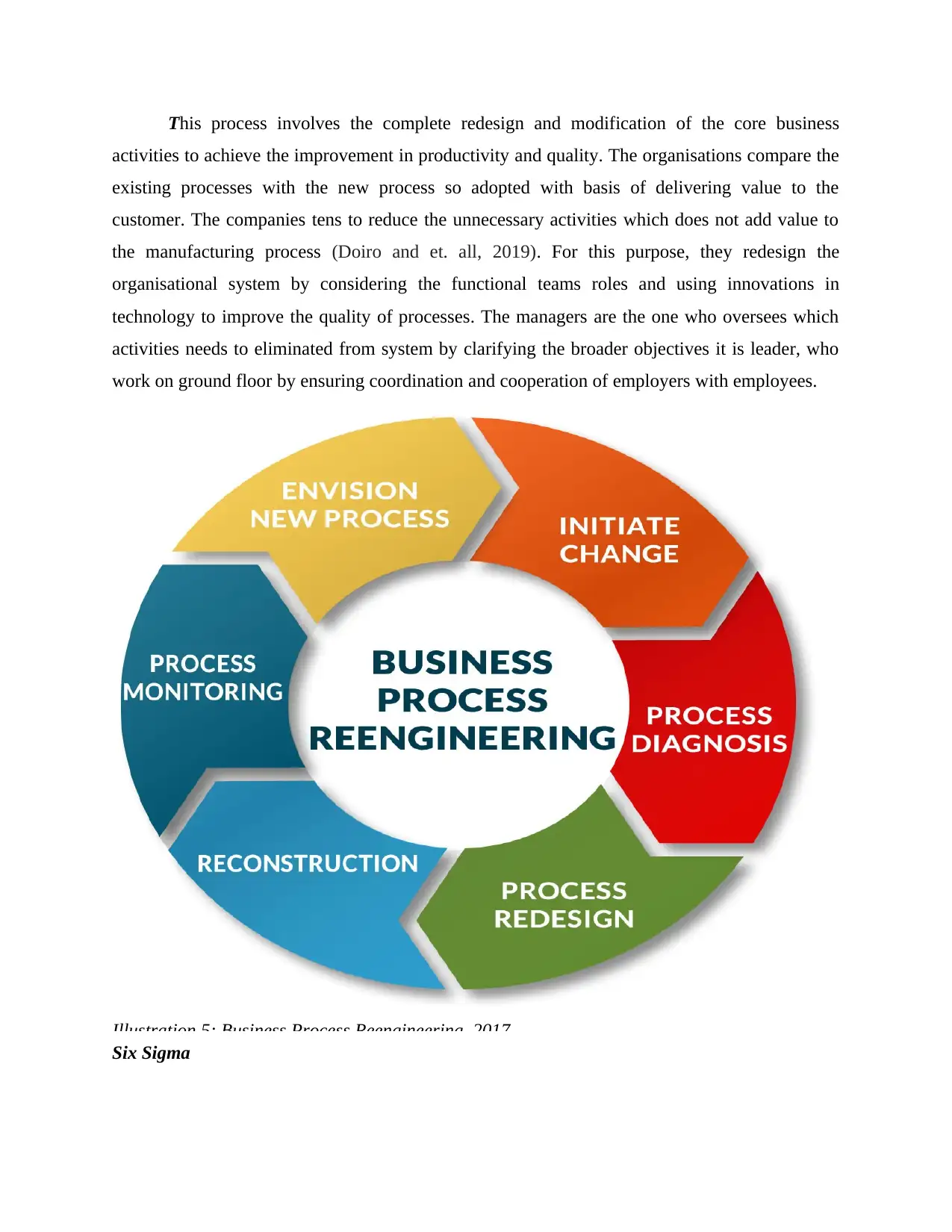
This process involves the complete redesign and modification of the core business
activities to achieve the improvement in productivity and quality. The organisations compare the
existing processes with the new process so adopted with basis of delivering value to the
customer. The companies tens to reduce the unnecessary activities which does not add value to
the manufacturing process (Doiro and et. all, 2019). For this purpose, they redesign the
organisational system by considering the functional teams roles and using innovations in
technology to improve the quality of processes. The managers are the one who oversees which
activities needs to eliminated from system by clarifying the broader objectives it is leader, who
work on ground floor by ensuring coordination and cooperation of employers with employees.
Illustration 5: Business Process Reengineering, 2017
Six Sigma
activities to achieve the improvement in productivity and quality. The organisations compare the
existing processes with the new process so adopted with basis of delivering value to the
customer. The companies tens to reduce the unnecessary activities which does not add value to
the manufacturing process (Doiro and et. all, 2019). For this purpose, they redesign the
organisational system by considering the functional teams roles and using innovations in
technology to improve the quality of processes. The managers are the one who oversees which
activities needs to eliminated from system by clarifying the broader objectives it is leader, who
work on ground floor by ensuring coordination and cooperation of employers with employees.
Illustration 5: Business Process Reengineering, 2017
Six Sigma
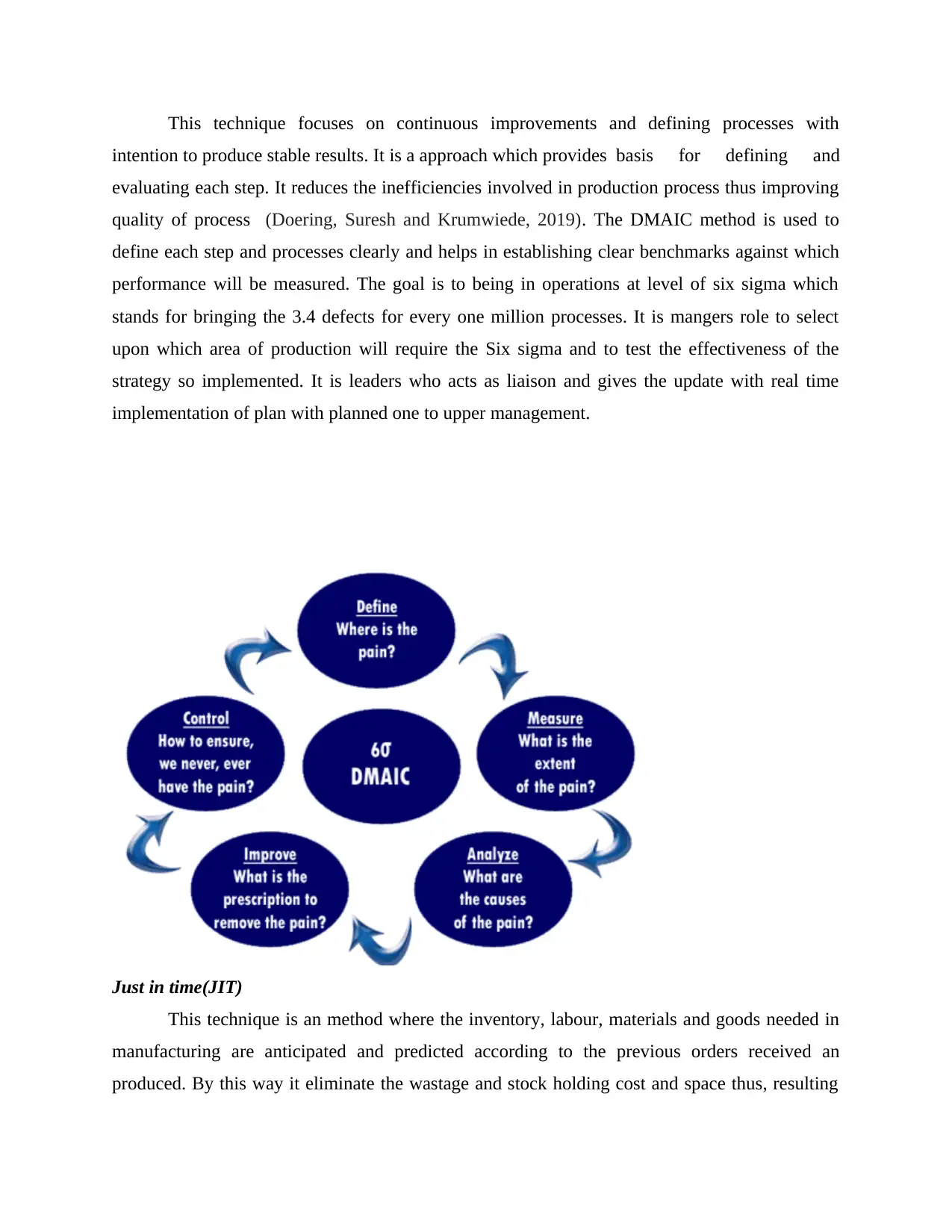
This technique focuses on continuous improvements and defining processes with
intention to produce stable results. It is a approach which provides basis for defining and
evaluating each step. It reduces the inefficiencies involved in production process thus improving
quality of process (Doering, Suresh and Krumwiede, 2019). The DMAIC method is used to
define each step and processes clearly and helps in establishing clear benchmarks against which
performance will be measured. The goal is to being in operations at level of six sigma which
stands for bringing the 3.4 defects for every one million processes. It is mangers role to select
upon which area of production will require the Six sigma and to test the effectiveness of the
strategy so implemented. It is leaders who acts as liaison and gives the update with real time
implementation of plan with planned one to upper management.
Just in time(JIT)
This technique is an method where the inventory, labour, materials and goods needed in
manufacturing are anticipated and predicted according to the previous orders received an
produced. By this way it eliminate the wastage and stock holding cost and space thus, resulting
intention to produce stable results. It is a approach which provides basis for defining and
evaluating each step. It reduces the inefficiencies involved in production process thus improving
quality of process (Doering, Suresh and Krumwiede, 2019). The DMAIC method is used to
define each step and processes clearly and helps in establishing clear benchmarks against which
performance will be measured. The goal is to being in operations at level of six sigma which
stands for bringing the 3.4 defects for every one million processes. It is mangers role to select
upon which area of production will require the Six sigma and to test the effectiveness of the
strategy so implemented. It is leaders who acts as liaison and gives the update with real time
implementation of plan with planned one to upper management.
Just in time(JIT)
This technique is an method where the inventory, labour, materials and goods needed in
manufacturing are anticipated and predicted according to the previous orders received an
produced. By this way it eliminate the wastage and stock holding cost and space thus, resulting
⊘ This is a preview!⊘
Do you want full access?
Subscribe today to unlock all pages.

Trusted by 1+ million students worldwide
1 out of 18
Related Documents
Your All-in-One AI-Powered Toolkit for Academic Success.
+13062052269
info@desklib.com
Available 24*7 on WhatsApp / Email
![[object Object]](/_next/static/media/star-bottom.7253800d.svg)
Unlock your academic potential
Copyright © 2020–2025 A2Z Services. All Rights Reserved. Developed and managed by ZUCOL.





